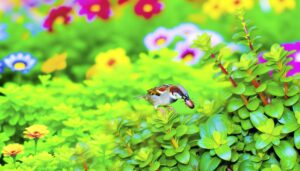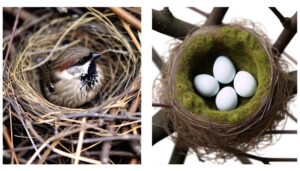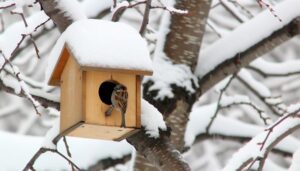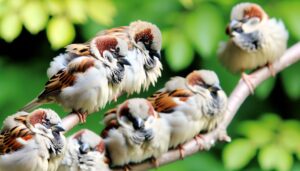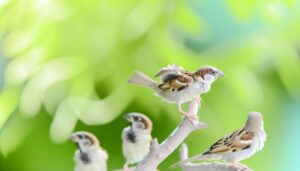7 Steps to Keep Sparrows Out of Your Martin House
To effectively keep sparrows out of martin houses, adopt multiple strategies rooted in understanding sparrow behavior. Utilize sparrow-resistant entry points, such as crescent-shaped entrances, to bar sparrows while allowing purple martins access.
Regularly monitor and maintain the martin house to promptly remove sparrow nests. Implement sparrow traps and offer alternative nesting sites distant from the martin house.
Limit food sources by modifying bird feeders and employing visual deterrents like reflective materials and predator decoys. Proper housing placement and ongoing maintenance are also essential to ensuring a sparrow-free environment.
Explore further to grasp each method's specifics and efficacy.
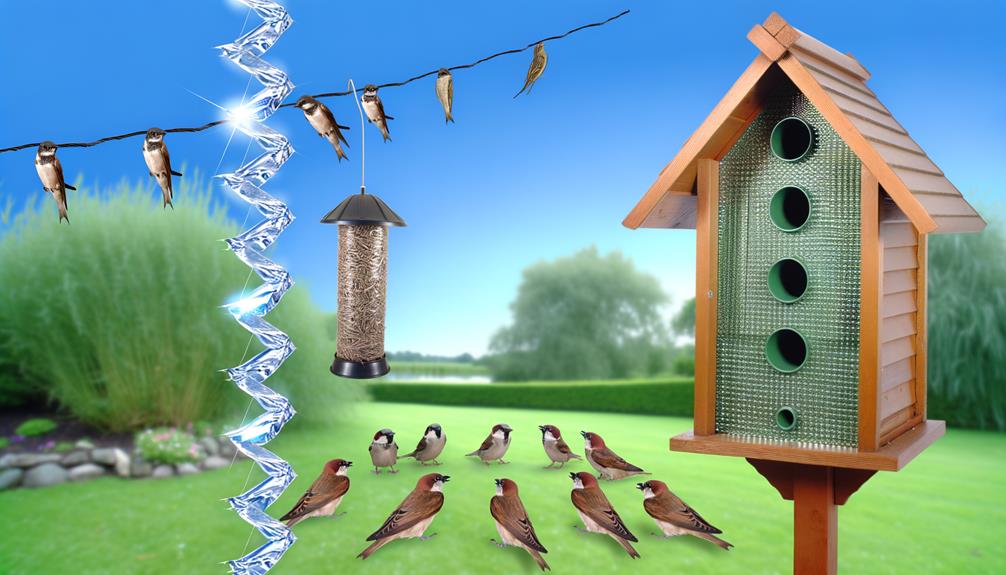
Key Takeaways
- Install sparrow-resistant entry points with a diameter of 1.75 inches or crescent-shaped openings.
- Regularly monitor and remove sparrow nests from the martin house.
- Use sparrow traps like repeating or nest-box traps and check them frequently.
- Remove food sources by modifying bird feeders and cleaning spilled seeds.
- Hang reflective materials or predator decoys to deter sparrow presence.
Identify Sparrow Behavior
Understanding sparrow behavior is crucial for effectively preventing these invasive birds from occupying martin houses. House sparrows (Passer domesticus) exhibit aggressive territorial tendencies, often competing with native purple martins for nesting sites. Observing their nesting preferences reveals that sparrows favor cluttered environments rich in food sources.
They are highly adaptable, quickly exploiting artificial structures for breeding. Importantly, sparrows can often be seen carrying nesting materials such as grasses and feathers to potential sites. Their vocalizations, characterized by a series of chirps and chatter, serve as auditory markers of their presence.
Recognizing these behaviors can aid in timely identification and intervention, ensuring that martin houses remain exclusive to their intended avian residents.
Use Sparrow-Resistant Entrances
Implementing sparrow-resistant entry points is a scientifically proven method to deter house sparrows from invading martin houses while allowing native purple martins to nest undisturbed.
These specialized entry points are designed with specific dimensions that capitalize on the size and behavior differences between the two species. Typically, an entry hole measuring approximately 1.75 inches in diameter is ideal; it is sufficiently large for purple martins but too small for the broader-bodied house sparrows.
Additionally, crescent-shaped or starling-resistant entry points can further guarantee that only the intended avian tenants can access the nesting compartments. By utilizing these entry points, you enhance the selectivity of the martin house, thereby promoting a more hospitable environment for purple martins and reducing competition from invasive sparrows.
Install Sparrow Traps
Installing sparrow traps is a strategic and effective measure to manage house sparrow populations and protect the nesting sites of purple martins. Sparrow traps are specifically designed to capture house sparrows without harming other bird species. These traps can be placed inside or near the martin house, targeting areas where sparrows are most likely to intrude.
Common designs include repeating traps, which can catch multiple sparrows, and nest-box traps, which activate when a sparrow enters. Regularly checking and emptying these traps guarantees they remain functional and effective.
Regularly Monitor the House
Regular monitoring of the martin house is crucial to effectively manage and deter sparrow infestations. By observing nesting patterns and conducting weekly maintenance checks, one can promptly identify and remove any sparrow nests before they become established.
This proactive approach guarantees the martin house remains a prime environment for its intended occupants.
Observe Nesting Patterns
Consistent monitoring of the martin house is essential to accurately identify and record the nesting patterns of both martins and sparrows. By observing the nesting habits, one can discern the distinct behaviors and preferences exhibited by each species. Martins typically construct nests using mud, grass, and feathers, while sparrows often utilize coarser materials like twigs and straw.
Detailed logs should be maintained, noting the frequency, duration, and location of nest-building activities. This meticulous observation aids in early detection of sparrow intrusion, allowing for timely intervention. Additionally, understanding these patterns supports the establishment of a more conducive environment for martins, ensuring their successful habitation and breeding within the martin house.
Weekly Maintenance Checks
To complement the detailed observation of nesting patterns, weekly maintenance checks are vital to guarantee the martin house remains an ideal habitat free from sparrow interference.
Regular inspections should include verifying the structural integrity of the house, making sure all compartments are clean and free of debris. Observers should meticulously check for signs of sparrow occupation, such as nests or eggs, and promptly remove any found.
Additionally, it is essential to monitor for damage or wear that may provide sparrows with entry points. Documenting these checks can help track changes over time, allowing for timely interventions.
Utilizing a systematic approach ensures that the martin house remains a sanctuary for its intended residents, thereby promoting a thriving purple martin population.
Remove Sparrow Nests
Identifying sparrow nests is essential for maintaining the integrity of a Martin house. These invasive species can outcompete martins for nesting sites.
Safe nest removal involves using appropriate tools and techniques to guarantee minimal disturbance to the ecosystem.
Regular monitoring techniques, such as weekly inspections during the breeding season, help in early detection and management of sparrow nests.
Identify Sparrow Nests
Discerning sparrow nests within a martin house requires sharp observation of structural characteristics. Key indicators of sparrow nests include the presence of rough materials like twigs, grass, and feathers, often resulting in a disheveled and bulky appearance. This observational approach is crucial for accurately identifying and differentiating sparrow nests from those of martins, which typically exhibit more organized and refined construction.
Such careful observation guarantees precise identification, facilitating the subsequent steps for maintaining a martin-friendly environment.
Safe Nest Removal
Effective removal of sparrow nests from martin houses demands a cautious and compassionate approach to secure the safety and well-being of the birds and to maintain the integrity of the nesting site.
Begin by identifying active sparrow nests, typically characterized by rough construction and debris. Using protective gloves, gently disassemble the nest, guaranteeing minimal disturbance to the surrounding environment. Avoid removing nests during breeding season to prevent harm to eggs or chicks.
Employ tools such as a long-handled hook or pliers for inaccessible areas, and dispose of the nest material responsibly. Cleaning the nesting compartments with a mild disinfectant post-removal can deter future infestations.
This methodical approach secures the preservation of the martin house's primary purpose.
Regular Monitoring Techniques
Regular monitoring of martin houses is essential in promptly identifying and addressing sparrow nests to guarantee the habitation remains ideal for martins. Consistent observation allows for the early detection of sparrow activity, minimizing competition and ensuring the safety of martin fledglings.
Key techniques in effective monitoring include:
- Frequent Inspections: Conduct weekly checks during the nesting season to spot and remove sparrow nests before they become established.
- Detailed Records: Maintain logs of nest inspections, noting any sparrow activity and actions taken.
- Use of Nest Traps: Implement sparrow-specific traps to aid in identifying and removing invasive birds.
- Behavioral Observation: Monitor bird behavior around the martin house for signs of sparrow intrusion, such as aggressive encounters or frequent visits from sparrows.
These strategies foster a conducive environment for martins, promoting their successful habitation.
Offer Alternative Nesting Sites
Providing alternative nesting sites, such as dedicated sparrow shelters or boxes, can greatly reduce the competition for space in Martin houses. By strategically placing these alternative sites in your garden, sparrows can be encouraged to nest elsewhere, thereby preserving the Martin houses for Purple Martins. Observational studies suggest that the following designs and locations are most effective:
| Alternative Nesting Site | Ideal Placement |
|---|---|
| Sparrow-specific birdhouses | Away from Martin houses |
| Dense shrubbery | Near ground level |
| Open-fronted nesting boxes | Under eaves or in shaded areas |
| Natural cavities | Trees or man-made structures |
| Ground-level nesting areas | Among tall grasses or bushes |
This approach not only benefits Purple Martins but also promotes a balanced avian ecosystem.
Limit Sparrow Food Sources
Another strategic measure in managing sparrow populations around Martin houses involves limiting their food sources, thereby making the environment less appealing to them. Sparrows are opportunistic feeders and thrive in areas where food is plentiful. By curbing accessible food, you can effectively reduce their presence.
Observational studies suggest the following approaches:
- Remove Bird Feeders: Eliminate or modify feeders that lure sparrows, especially those with mixed seeds.
- Clean Up Spillage: Regularly clean areas under feeders to clear spilled seeds and grains.
- Seal Trash Bins: Securely close all garbage bins to prevent sparrows from scavenging.
- Limit Ground Feeding: Avoid spreading food directly on the ground, which can easily entice sparrows.
Implementing these practices can decrease sparrow activity around Martin houses.
Employ Visual Deterrents
How can visual deterrents be effectively utilized to discourage sparrows from inhabiting Martin houses?
Visual deterrents leverage the sparrows' innate aversions to certain stimuli. One effective method involves hanging reflective materials, such as aluminum foil strips or reflective tape, around the Martin house. The reflection and movement can create a visual disturbance that sparrows find unsettling.
Additionally, predator decoys, such as models of owls or hawks, can be strategically placed to simulate the presence of a threat. These decoys should be moved periodically to maintain their impact.
Another approach includes using brightly colored objects or holographic decals, which can confuse and deter sparrows. Employing these visual deterrents can notably reduce sparrow occupancy, thereby safeguarding the Martin house for its intended inhabitants.
Encourage Martin Presence
To effectively encourage martin presence, it is important to establish an environment that meets their specific nesting and habitat preferences.
Purple martins are colonial nesters and prefer open areas near water. To attract them, consider the following strategies:
- Install Proper Housing: Use martin houses with compartments measuring at least 6x6x6 inches.
- Ensure Adequate Height: Place houses 10-20 feet above ground to avoid predators.
- Keep Surroundings Open: Maintain a 40-foot radius free from tall trees or structures.
- Provide Consistent Maintenance: Regularly clean and monitor the houses to prevent occupation by sparrows.
Conclusion
Effectively managing sparrow intrusion in martin houses necessitates a multifaceted approach, akin to weaving a tightly-knit fabric of deterrents and attractants. By understanding sparrow behavior, utilizing sparrow-resistant entrances, and implementing regular monitoring, one can notably mitigate the impact of sparrows.
Complementary measures, such as removing sparrow nests, offering alternative nesting sites, and minimizing food sources, further fortify this integrated strategy. Visual deterrents and fostering a strong martin presence enhance the overall efficacy, creating an environment conducive to martin habitation.

